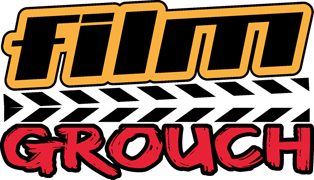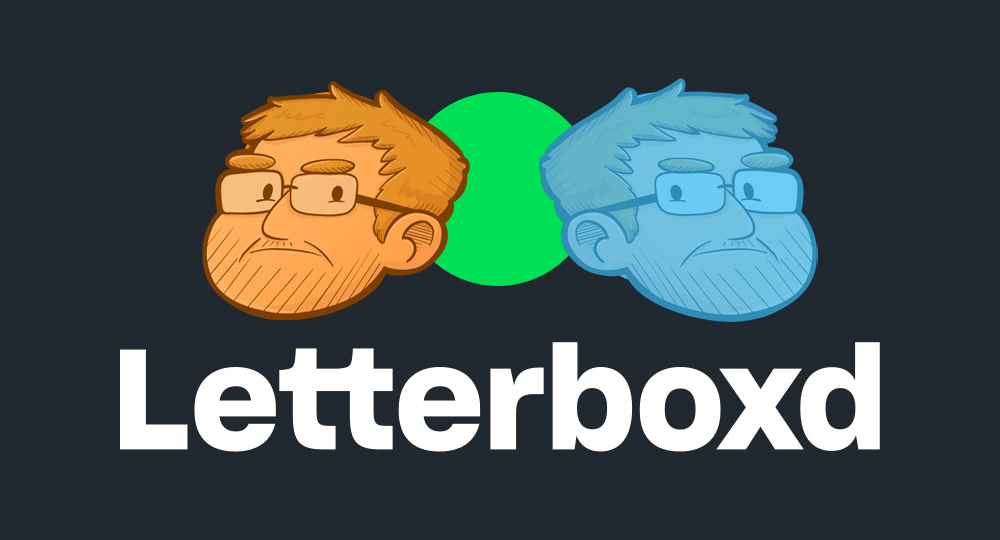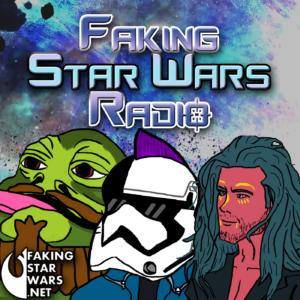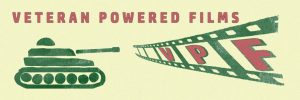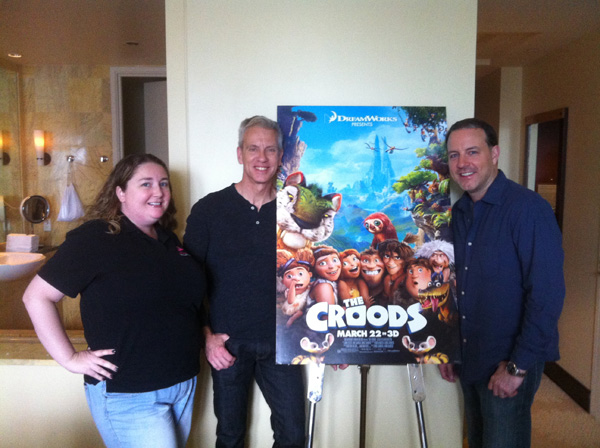
We shared our interview on NerdSpan.com as well, check it out!
It was a chilly day in South Beach, unseasonably so, when Madison Monroe and a few other local journalists and I sat down with Chris Sanders and Kirk De Micco, co-directors of The Croods, starring the voice talents of Nicolas Cage, Emma Stone, Clark Duke, Catherine Keener, Ryan Reynolds and Cloris Leachman (the mother-in-law with a tail).
The interview was for their work on The Croods, so we resisted the urge to ask Chris about being the voice of Stitch. Madison was pretty thrilled to be meeting one of her favorite Disney characters. But, I have a feeling after families check out The Croods, more kids will want to have their very own Belt. Chris Sanders voiced Belt, the world’s first pet.
After some pleasantries and caffeine pouring, the questions began.
Where did you guys get the idea to make a movie like The Croods?
Kirk De Micco: I originally started writing the story with John Cleese in 2004, and it was going to be a different movie, it was going to be stop-motion and was called Crude Awakenings at the time.
It still has that same concept of the fear of change, and John was really into it at that time, because he has a deathly fear of technology. And in 2007 I started talking to Chris about it and Grug and what it was, the fear of change, and from that it evolved into a story of a family. And what’s really relatable is the fear of the change going on inside your own family. And for a father the most scary change is when his daughter starts to fall in love with a boy. So that’s the arc of the evolution.
What message do you hope that people take from this film?
Chris Sanders: The message of this film, there are many different levels that are going on at the same time in this film. One of the ones I like to talk about is just the idea of change and risk. At the beginning of this film, Grug the dad, is trying to keep everyone together inside this cave. Just hide them away from danger, and he’s also trying to hide them away from change. Nothing frightens The Croods like something new.
Anything new is bad, right, it can’t be good, because new is risk and new is bad. But change finds them, their cave is destroyed, and it’s nothing that they could have ever stopped. And the interesting thing about this film is that the villain in this film is really change itself. In this film it’s a collapsing continent that pursues The Croods through the entire film. The idea that Grug is going to have to accept is that if this family is going to survive is that change is going to happen and they’re going to have to accept some level of risk and that’s the lesson that Grug learns at the end of the film . . . that, life is risk.
Rick Swift: What are some of the biggest risks that you have personally taken, Kirk and Chris?
CS: Career wise?
RS: Yea, nothing personal, just what you had to risk to make The Croods.
KD: One thing I think is relatable, you know, everyone has that fear of change, choosing a new school or getting a new job, or deciding you are going to go into a relationship. There’s always that fear that something is going to go wrong. But if you don’t try anything, it’s, you know . . . I don’t know if there’s any one personal one that I have; I live in constant fear – “Never not be afraid” is kinda my model as much as the line. I don’t know where to start with that, you’d probably be with me in therapy for many many years.
Madison Monroe: I wanted to talk about one of the voices from the movie, Emma Stone, she has a very distinctive voice, kinda raspy, but it’s really nice, so why did you think it would be good for the voice of Eep?
CS: You know, Kirk and I, she was our very first choice for the voice of Eep. And, a lot of the different things you’re looking for, one of them is that they inhabit their voice . . . very fully. I think it was the overall quality that Emma Stone had that drew us to her, we thought she was very very appealing. She inhabits that voice. Uhm, we do shoot the videos of the recordings so we can bring them to the animators later so that they can capture a little facial expression, gesture, timing, things like that, but most of what we come away with is a recording. And everything needs to be in that recording. So, uhm, there’s a warmth, there’s appeal, there’s a quirkiness.
KD: The quirkiness is what, you know, we actually, you know, kinda fell in love with her watching House Bunny. That was before we started, before like, everything, Easy A, But, you know how that character was . . .
MM: Natallllieee
KD: Exactly, yea, that’s what we wanted. We both felt like that was something we wanted. You know, Eep needs to have a bit of awkwardness, she’s a cave girl, she’s not so polished off, you know, and that’s what she does so well, and her timing is so impeccable.
Which characters were you most drawn to?
CS: Well, I have my human favorites and I have my animal favorites. My animal favorite is the giant tiger. I think that’s one of my very favorite characters I’ve ever worked on. The human characters, I think Eep, because that scene in the very beginning when she’s seeking light, and the idea that she passes that thing on to her dad, I think is one of my favorite things in the film.
KD: Well mine is Grug, obviously, because that’s like I said, I live in fear, and for animals . . . it’s kinda a toss up, but I grew over time to be falling in love with Douglas. Because I’m a dog guy, and I just felt like that, that, there’s the one shot where Grug is running for his life and he sees Douglas and Douglas is sitting there with this look on his face, and he’s just a sweet dog, you know.
What was the hardest part of making this movie?
CS: This has a very unusual story, it’s a road trip, and so for this movie the changes in the characters are internal, so because of that the physical journey the characters take in that was variable. We, again, we didn’t have a traditional villain that was going to pop out and confront the characters. So really all these changes are internal changes, and that was probably the hardest thing about this film.
Writing it and story-boarding it to finding the actual path that they took. We made a lot of changes, they went to a lot of places that you’ll never see in this film. But, it’s all about triggering the correct responses inside the characters. That was the quest.
KD: Another one I think was the, you know, it’s completely a fantasy world. There’s nothing that we could rely on. You go, oh well, that’s a building, we could just make a building. We know how to make that. Oh, they walk into a room, ok, that’s got four . . . . you have something to start with. Here we had nothing to start with, so all the artists at DreamWorks were like . . . WOW, we can do anything we want . . . and after about six months they’re like, uh, where do we start? So everything you see there is from their imaginations, you know, it’s their fantasy world.
Rick Swift: Whose decision was it to cross a Macaw and a Sabretooth? I know you said that was your favorite character, so.
CS: Yes, I did design that one character. We were trying to do combination animals, it was an idea that one of our developing artists came up with, named Shane Prigmore, and very early on in the design process, he did a single drawing of an animal that was a combination of two different creatures that we know. And we thought, that’s a great way to go. So we imagined if you rolled backwards in time that maybe all these animals that we know today may have been fused together and they separated at some point. And the tiger was an interesting one, because he’s a staple.
I felt very strongly that we should have a couple of staples of our prehistoric world that we are all very familiar with. So we have a mammoth and we have a Sabre-tooth tiger, he’s our sabre-tooth tiger. So, the best combination we could think of was maybe the coloration. He has a green macaw coloration to him that I think is just stunning.
RS: It really is visually exciting, yea.
Did you learn anything new about yourselves during the filming?
CS: That’s a good question, that’s a very good question. I think for myself, and it’s coming for Kirk, . . . it’s coming. I have a daughter, and she’s seven now, and the dad daughter relationship in the film was something that was very new, because I’ve been on this film for about five years. And that was a very new relationship for me when I began the film, so I think that just learning about that type of relationship while I was home and then bringing that to work and putting some of that into the movie I think was probably the thing that was evolving as we were making this film.
KD: I would say pretty much the same, because I started this like in 2004, and writing about a father for about eight/nine years and now I just had twins last week, so, there we have it. I don’t know if it’s life imitating art or art imitating life.
What did you take from How to Train Your Dragon to use in The Croods?
CS: In Croods we pushed the 3D harder, Croods is a different type of film, it’s a different tone, it has a much broader tone, we have bigger action, almost like cartoony, if you will. Especially the opening sequence. It allowed us, in the moments that were appropriate, to push it literally to the breaking point. We have moments where things come out into the audience and you can’t bring them out further. The technology just will stop.
KD: Your eyeballs will go in, there’s nowhere left.
CS: For me with How to Train Your Dragon, that was my crash course in all things, CG. And I took every little bit of the knowledge I gained from How to Train Your Dragon and brought that all to Croods and there were big changes on Croods when I came back, because I better understood what this CG thing could achieve. So when I came back, both Kirk and I started pushing things on the Croods a lot harder visually to be more believable, in a sense of having things be more realistic and things. Just because this film is about consequences of decisions. So you need to believe in the world the Croods are in, so a lot of the stuff is broader.
We wanted to ask probably about a thousand more questions of each of them, but they had to be a million other places and in no time. You don’t think about the amount of hard work that goes into a film when you sit back and just demand to be entertained. It is nice to meet people so passionate about their work, and it translates incredibly well in their overall product. I can’t wait for everyone to see The Croods, to meet them and understand their own families a little better perhaps.
We hope Chris and Kirk keep making great films, and we look forward to meeting them again. Plus, it was a miracle I kept Madison from stealing that Belt prop at the Mandarin Oriental! I’m not gonna lie, I wanted it to, for my son, yea, for my son.
